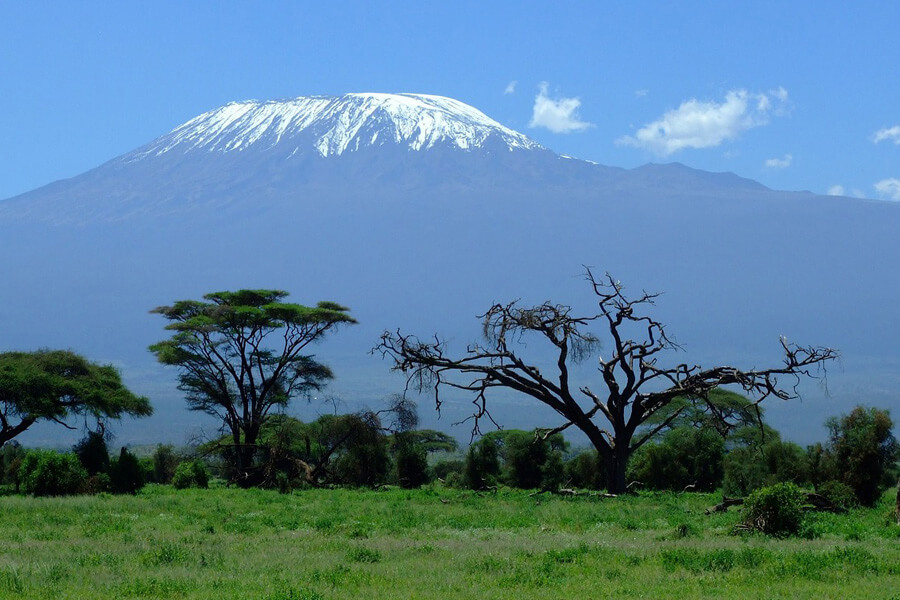With the free-standing Mountain of Kilimanjaro, Kilimanjaro National Park covers an area of 1,688 square kilometers. Kilimanjaro National Park is located near the region of Moshi in Tanzania.
It was established as a national park in 1973 and declared a World Heritage Site by UNESCO in 1987. The park’s popular feature is Mount Kilimanjaro which is at the heart of Kilimanjaro National Park.
Mount Kilimanjaro is a three million-year-old stratovolcano and the tallest mountain in Africa with an altitude of 5,895 m. The mountain has 3 volcanic cones namely; Kibo, Mawenzi, and Shira that were formed about 1 million years ago.
There are pastures and bushlands of the native Maasai people at the boundary of the national park. Streams from the summit with a belt of tropical rainforest are also found in this region.
It is home to elephants, the endangered Abbott’s duiker, antelopes, and primates. There are over 179 bird species in the area and thus an excellent destination for birding.
Alpine meadows can be found after the rainforest 4000 meters where the landscape changes to towering stems of giant lobelias. Above the giant lobelias, there are only mosses and lichens clinging to the rocks.
Thereafter, snowfields lead to three craters, Mawenzi and Shira, which are dormant, and Kibo, the summit, where gas fumaroles are intermittently active.
Various animals can be found in the park including warthogs, hippos, impalas, dik-diks, zebras, elephants, buffalos and giraffes, elands and gazelles, Cheetahs, lions and leopards, jackals, hyenas, monkeys, baboons, mongooses, and many others.

Mountain climbing is one of the most sought-after activities in Kilimanjaro National Park. It is one of the most adventurous climbs in Africa.
There are seven routes to the summit of Mt Kilimanjaro namely; Lemosho, Machame, Marangu, Rongai, Northern Circuit, Shira, and Umbwe. There’s also a descent-only route called the Mweka route. Each of the seven Kilimanjaro routes has its pros and cons, like cost, scenic variety, and summit success rate.
Climbing to the summit offers an opportunity to experience almost every type of ecological system in one go. The ecosystems include; cultivated land, rain forest, heath, moorland, alpine desert, and an arctic summit.
The climb up Mount Kilimanjaro is an amazing experience with scenic views of the surrounding plains on the way up the mountain.
Wildlife viewing can be done during game drives (both day and night) and nature walks. Animals are not very abundant in this national park with about 30 Animal species.
These include warthogs, hippos, impalas, dik-diks, zebras, elephants, buffalos, and giraffes. On Lucky days, a leopard can be spotted in the park.
There are over 179 bird species in the area which makes Kilimanjaro National Park an excellent destination for birding. This includes endemic species of birds that cannot be seen anywhere else in the world.
The most commonly seen birds are Turacos, silvery-cheeked hornbills, kingfishers, cuckoos, bee-eaters, African Pitta and so many more.
Plenty of different primate species such as baboons, blue monkeys, black-faced monkeys, and many others make primate trekking a key activity to do in Kilimanjaro National Park.
These primates are found swinging from tree to tree in the park’s rainforest.
Lake Chala is a crater lake at the border between Kenya and Tanzania. The lake is good for the site seeing as the waters change color from turquoise to emerald green depending on the time of the year.
There are also camps around the lake from which visitors can view the lake.

The best time to visit Kilimanjaro National Park will vary according to your interests. Animals are easier to spot when vegetation is sparse and dry from July to October.
Later when the heavier rains arrive around mid-March, April, and May, a shallow salt lake forms. Waders gather in the shallow salty water while lush new vegetation shelters the nests of weaver birds. These conditions are best for bird-watching.
The recommended means of travel is a flight to Kilimanjaro International Airport and then a drive to the national park. Kilimanjaro National Park is 76.5 km away from Kilimanjaro International Airport which is a 1.5-hour drive of amazing scenic views.
The park can also be accessed from other national parks in the northern circuit of Tanzania.
Most of the accommodations in Mount Kilimanjaro National Park are found in the western part of the park. There are some huts and campsites on the mountain slopes within the park.
It is also possible to stay in hotels outside Kilimanjaro National Park in Moshi town.
